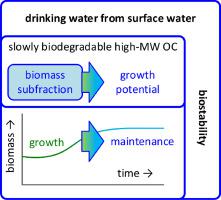Water Research ( IF 12.8 ) Pub Date : 2021-11-26 , DOI: 10.1016/j.watres.2021.117898 R Schurer 1 , W A M Hijnen 2 , A van der Wal 3

|
Drinking water must be sufficiently biostable to avoid excessive microbial and invertebrate growth in disinfectant-free distribution systems. The production of biologically stable drinking water is challenging for conventional surface water treatment plants using reservoirs as feed water due to the presence of slowly biodegradable particulate and high-molecular weight biopolymeric organic carbon (high-MW OC) which increases the Microbial Growth Potential (MGP) in the feed water and produced drinking water. The study presented here provides new insights in the relationship between high-MW OC and MGP for a full-scale surface water treatment plant. Controlled-conditions addition series experiments showed that MGP increases linearly with the high-MW OC concentration with a seasonally variable ratio. Laboratory filtration indicated that MGP is mainly attributable to the high-MW OC subfraction of > 0.12 µm particle size coinciding with microbial biomass. Intensive field monitoring revealed clear seasonal patterns in the plant's feed water and treated water levels of high-MW OC, biomass and MGP. These parameters reach maximum levels in the periods of high water temperature with the notable exception of the treated water's high-MW OC concentration which exhibits an opposite seasonal pattern (reflecting seasonally variable removal in the treatment). Moreover, the field monitoring showed that MGP correlates well with the concentrations of biodegradable biopolymeric OC and with microbial biomass measured as ATP (adenosine triphosphate) and cell counts, but not with the total high-MW OC concentration in the treated water. Theoretical estimations showed that the OC quantities present in and consumed by the microbial biomass are in the same order of magnitude as slowly biodegradable biopolymers. From these results it is concluded that specifically the microbial biomass-associated and biodegradable biopolymeric OC subfraction of the totally present high-MW OC is important for MGP. Finally, the MGP-assay results and theoretical calculations showed for the high-MW OC matrix that the microbial biomass’ OC consumption for maintenance is significant vis-á-vis that for growth, and that stable and high levels of biomass are sustained in the treated water which may adversely affect biological stability in the distribution network.
中文翻译:

高分子量有机碳的生物质亚组分对地表水生产的无消毒饮用水的微生物生长和维持潜力的意义
饮用水必须具有足够的生物稳定性,以避免在无消毒剂分配系统中过度生长微生物和无脊椎动物。由于存在可缓慢生物降解的颗粒和高分子量生物聚合有机碳(高 MW OC)会增加微生物生长潜力(MGP),因此使用水库作为给水的传统地表水处理厂生产生物稳定的饮用水具有挑战性) 在给水和生产的饮用水中。此处介绍的研究为全面地表水处理厂的高 MW OC 与 MGP 之间的关系提供了新的见解。受控条件添加系列实验表明,MGP 随高 MW OC 浓度呈线性增加,具有季节性变化的比率。实验室过滤表明 MGP 主要归因于 > 0.12 µm 粒径的高 MW OC 亚组分与微生物生物量一致。密集的现场监测揭示了工厂给水和高分子量 OC、生物量和 MGP 处理水水平的明显季节性模式。这些参数在高水温期间达到最高水平,但处理水的高 MW OC 浓度显着例外,该浓度表现出相反的季节性模式(反映处理中季节性变化的去除)。此外,现场监测表明,MGP 与可生物降解的生物聚合 OC 的浓度以及以 ATP(三磷酸腺苷)和细胞计数测量的微生物生物量相关,但与处理水中的总高 MW OC 浓度无关。理论估计表明,微生物生物质中存在和消耗的 OC 数量与可缓慢生物降解的生物聚合物处于同一数量级。从这些结果可以得出结论,特别是完全存在的高 MW OC 的微生物生物质相关和可生物降解的生物聚合 OC 亚部分对 MGP 很重要。最后,MGP 测定结果和理论计算表明,对于高 MW OC 基质,微生物生物量维持的 OC 消耗与生长消耗相比显着,并且稳定和高水平的生物量在可能会对配水网络中的生物稳定性产生不利影响的处理过的水。


























 京公网安备 11010802027423号
京公网安备 11010802027423号